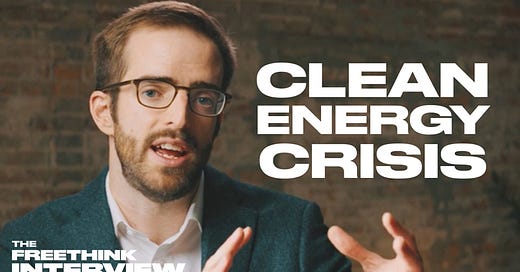The green revolution is here—but outdated laws are blocking its progress. Alec Stapp of the Institute for Progress explains how plummeting solar, wind, and battery costs should be fueling a clean energy boom, but bureaucratic red tape is slowing it down.
Timestamps:
00:00: Mission: decarbonization
01:21: The barrier to energy infrastructure
02:58: Adversarial legalism
03:49: “Significant impact”
05:19: Permitting reform
07:27: Building AI infrastructure
Transcript:
Mission: decarbonization
Energy is one of the primary inputs to the entire economy. There is no rich country that uses very little energy. If you're asking people to use less energy, in effect, you're asking them to become poorer. At the same time, we have to think about climate change as a national emergency. That means we're short on time. We need to focus narrowly on our mission, on the goal, which is decarbonization and mitigating the effects of climate change. And if you look at reasons for optimism, over the last 50 years, the price of solar panels has fallen by 99.5%. The price of lithium ion batteries over the past 30 years has fallen by 97%.
That means that renewable energy, like solar and wind, are much cheaper than fossil fuels. So the market wants to build more renewable energy, more clean energy infrastructure, but our current environmental review laws and other procedural statutes slow them down. So you get these really perverse outcomes where you think these laws are supposed to protect people and nature, but actually they can be very antihuman. Hi, I'm Alec Stapp. I'm the cofounder of the Institute for Progress. We're a bipartisan innovation policy think tank based here in Washington, DC.
The barrier to energy infrastructure
The main barrier to building any kind of energy infrastructure in the United States today is primarily around permitting. Do you have the authority, the permission of the government, to actually build your large-scale energy infrastructure projects? So for example, in the United States, we have local, state, and federal authorities that are often involved. If any one authority doesn't want a project to go through, they can block it. So you need a 100% consensus to build major projects.
So for example, transmission lines are the hardest type of infrastructure to build in the United States. It's really important to be able to move electricity from where it's produced to where it's consumed. Most of our best solar resources are in the southwestern and southern United States, and most of our best wind resources are in Tornado Alley or the Great Plains. And those states are now often exporting clean electricity to other states on the coast. And so connecting our grid across regions matches the supply and demand a lot better, and also makes us more resilient to natural disasters.
But any kind of linear infrastructure that spans multiple jurisdictions runs headlong in that problem I was talking about earlier, where you need sign-off from the private property owners, local governments, state governments. And often, states that don't want a project for any kind of idiosyncratic reason, will withhold their permission. With multiple different checks on a project, different veto points, any kind of major interregional transmission project takes 10 or more years on average because of all these hurdles they need to clear.
Adversarial legalism
And then furthermore, given our court system, given what legal scholars have called adversarial legalism in the United States, there are lots of opportunities for outside groups, people not in the government, to sue projects they don't like and ultimately slow them down and eventually kill them through delay. And the main tool in their arsenal is the National Environmental Policy Act, passed into law in 1970. The key thing to know about NEPA is that it's purely an environmental procedure law. There is no substantive environmental protections in NEPA. Our substantive environmental laws are things like the Clean Air Act and Clean Water Act that ensure that corporations can't dump toxins into the water or spew toxins into the air. NEPA, on the other hand, just says you need to thoroughly document every potential significant impact of a project, as well as alternative mitigating measures you could take.
“Significant impact”
[Interviewer] Could you define significant impact for us? What exactly does that mean?
Yeah, so therein lies the problem, is how do you define significant impact? It's kind of in the eye of the beholder. No one can agree on what that term actually means, and it's litigated in courts and decided by judges. And what judges believe it means grows and expands over time. NEPA is the ultimate litigation threat. It's the most litigated environmental statute in the entire United States, because if you just miss one potential significant impact or don't thoroughly consider every possible alternative, a judge might look at the 1700-page review that took four and a half years and say, "Well, you didn't consider this one alternative impact that the plaintiff is arguing you should have considered. We're gonna send it back to the federal agency that issued the permit for the project and demand they do more review." Advocacy groups have practiced and weaponized NEPA over the decades to know how to sue projects, in which jurisdictions, which claims to bring. And they will explicitly, on the record, tell you the strategy is delay, delay, delay until the project dies. That doesn't in practice actually fix any kind of environmental issue. It merely delays a project from being built. This kind of uncertainty in our legal system hinges on a very vague, ambiguous statute like NEPA. And so it's gonna be incumbent upon Congress to take more action.
Permitting reform
At its base, permitting reform means making it easier to build infrastructure in the United States, having more automatic approvals for projects. If your solar project or your wind project meets some prespecified criteria, you would get automatic approval. There'd be no long procedural review of the project because you're automatically qualified. Geothermal, for example, produces roughly half a percent of US electricity currently, but it has great potential to be a source of clean, firm energy generation that we need in the future to complement intermittent technologies like solar and wind. Geothermal projects can go up through six separate environmental reviews; contrast that with certain fossil fuel projects that have a categorical exclusion from environmental review. All of that uncertainty leads to insufficient investment in geothermal. For transmission infrastructure, we have to get separate sign-off from every single state. But if you wanna build a pipeline, the federal government can preempt state authorities. All of that is around policy decisions that we could make differently. We could reduce the proceduralism inherent in laws like NEPA while beefing up our substantive statutes. We've learned a lot in the last few decades about how harmful dirty, polluted air is to human health. We could raise the national ambient air quality standards in the Clean Air Act to a higher level to reflect that better understanding we have of the harmful effect on human health.
There's also reforms to judicial review. Right now, that uncertainty created by the court system, that could be fixed if we set a time limit on judicial injunctions. Congress could say there's a one-year time limit after a project has been approved under which the court can make sure that nothing was missed. But it's not gonna be an indefinite process going forward. But then there are lots of other reforms in terms of who can sue projects, who has standing. You could limit that to people who live in the local community or who filed the complaint early in the process, to kind of limit this situation where outside groups who don't even live in an affected community are suing projects on their behalf.
Building AI infrastructure
[Interviewer] So in the background of this whole conversation is all the energy that we'll need as we build out our AI infrastructure in this country. What impact do you think that will have on our existing grids?
How much energy data centers use is potentially the hottest topic in at least DC tech policy debates currently, because it's highly uncertain how much they're gonna use in the future. These data centers, they're so large and electricity is so important they're actually measured in terms of not the square footage, not even necessarily as commonly the cost, but how many megawatts of electricity do they use to run the project because it's the primary input.
There are current plans by OpenAI to build a five-gigawatt hyperscale AI data center. They're calling it Stargate. They hope to have it fully online by 2030. And that's going to be a huge localized impact, whether it connects to the grid or if it's behind the meter and has its own dedicated power sources; either way, in that region of the country, you're going to have to build a lot of dedicated capacity to power that. All data centers combined in the United States, not just AI data centers, that's currently 2.5% of all US electricity. So almost a rounding error in terms of our electricity consumption. Some projections show it growing to 5% by 2030. People who are very bullish on the future of AI say that might go even higher than that. How does the electricity infrastructure system change during that time? Are we incentivizing and streamlining regulations for building more solar, wind, geothermal, nuclear, and the transmission lines to carry that electricity across our country?
If we don't update our rules and regulations to make it easier to build AI data centers here in the United States, we risk losing the lead in terms of technological supremacy on artificial intelligence. These data centers will be built somewhere in the world. We want to make sure that is built in the United States and ideally controlled by the United States. So much of human flourishing, well-being relies on policy. We think it's the biggest lever for improving outcomes and improving human well-being. So if you think about the I-95 bridge collapse in Pennsylvania...
Several northbound lanes of I-95 in Philadelphia collapsed after our tanker truck fire erupted underneath an overpass. Governor Shapiro went on TV and said this is an emergency. That means around-the-clock work that you've seen going on here during the demo phase is going to continue until this road is reopened. And they reopened it in less than two weeks, and they pulled out all the stops.
They didn't let proceduralism slow them down. They got it done. And we often do that more for highways than we do for transit projects or clean energy projects. But it shows that when there is the willpower and focus from policymakers at the top, we can still build things in this country.









Share this post